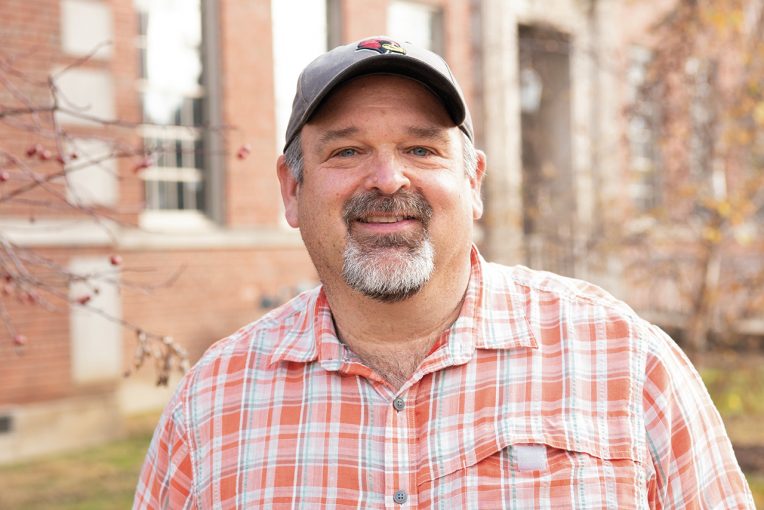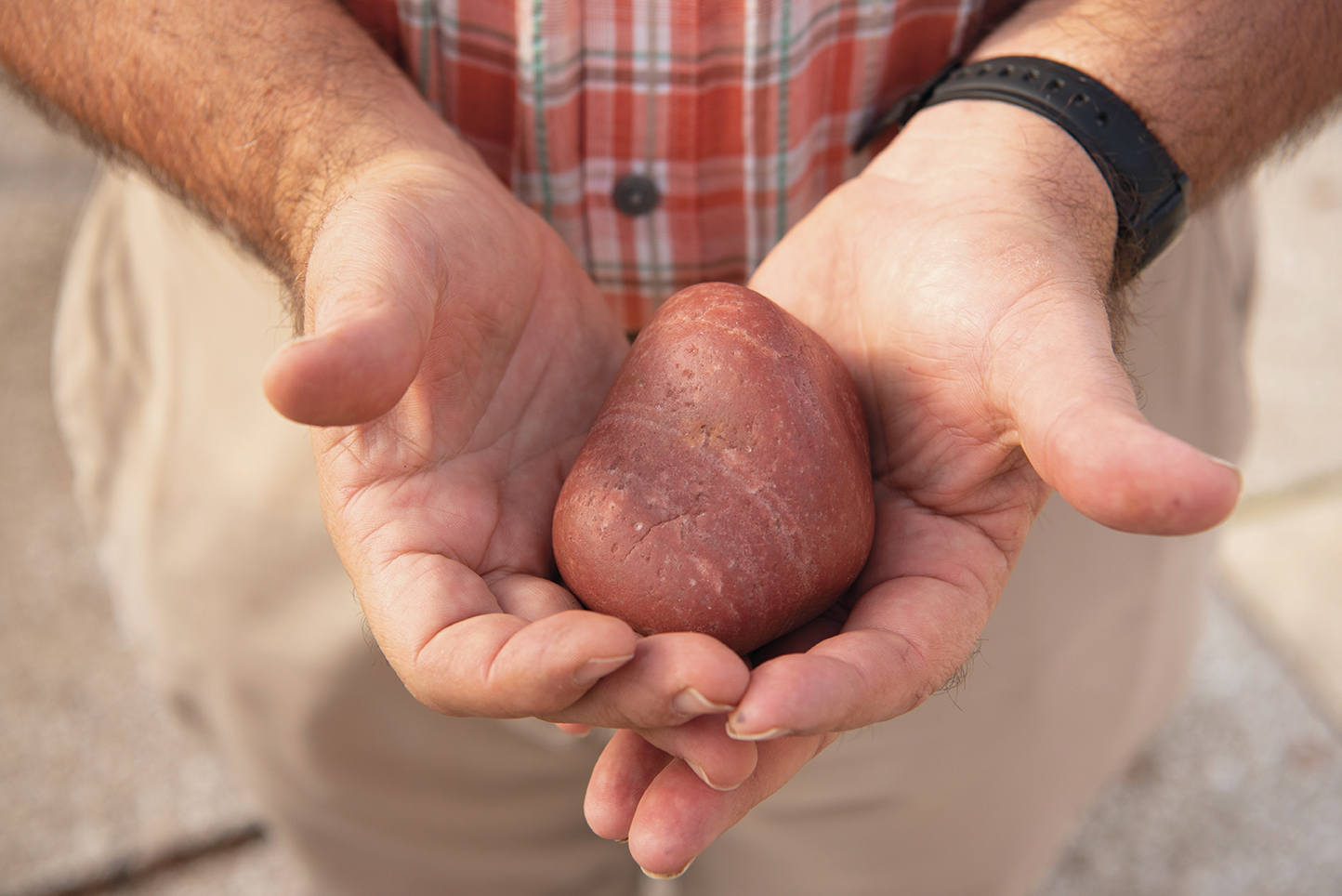Dr. David Malone ’88 is an expert on many topics, but dinosaurs are not among them. The Distinguished Professor of Geology’s academic biography points to his expertise in structural, sedimentary, and field geology. In other words, he knows an awful lot about rocks, sand, and the age and provenance of such things that date back millions upon millions of years.
“Nobody would call me a dinosaur expert, especially me,” said Malone.
His son Josh is no dinosaur expert either. Nevertheless, Josh’s inquisitiveness led the pair to question how some prehistoric rocks that David found in Wyoming had made their way from Wisconsin a long time ago. The pair concluded dinosaurs brought them. The Malones published their findings last spring in the geology journal Terra Nova. The article garnered national attention, including a writeup in The New York Times.
“I’ve done some really cool stuff, but I’ve mostly gotten interest from other scientists, this little realm of specialists,” Malone said. “Plus, we’ve had a field camp capstone for our geology majors that we’ve been running for 50 years. Over the 29 years I have been involved, I have had the pleasure of working with almost 800 students from more than 50 universities. I’ve done a lot of creative science, hard science, but I’ve never been picked up by The New York Times and other international publications. The word dinosaur is what did it.”
Appears InMalone, who earned his bachelor’s degree in geology from Illinois State, has been on faculty at his alma mater in the Department of Geography, Geology, and the Environment since 1994. He earned his master’s degree and a Ph.D. at the University of Wisconsin.
During his tenure at Illinois State, he has been an associate professor, full professor, and department chair, and is now Distinguished Professor. He’s also been named Outstanding University Teacher, Outstanding College Researcher, and Arts and Sciences Distinguished Lecturer. Funding for his work put him in the Million Dollar Club in 2008. He is a fellow of the Geological Society of America, which recognized his field camp with the Exxon-Mobil Field Camp Excellence Award.
In the following Q&A, Malone talks about how a “nice father-son project” has become an unexpected bonus to a career devoted to teaching and scientific inquiry.
You’re a geologist, so how did you get interested in dinosaurs so late in your career?
By accident. In 2017, my son Josh was an undergraduate at Augustana (College) and was interning in the Bighorn Mountains in Wyoming. He was at a field station at the top of the mountains working as a camp hand hired to write social media stories. They were under 6 feet of snow at the first of June, so he couldn’t take any photos or write any stories. He came and stayed with us near Sheridan and Cody, Wyoming, for a couple of weeks, hanging out with me and my students in Greybull, Wyoming. It’s one of the field camps we go to in the Bighorn Basin near the Bighorn River. I had him come be our social media coordinator.
On the last day of each project I try to make myself scarce so students can finish their work. That’s when I go around and pick up pretty rocks and fossils to give away as my calling card to teachers and students. The rocks were gastroliths, which are from dinosaurs’ stomachs. We were collecting them because all teachers need something that’s been in the stomach of a dinosaur. And, my son, like any good student, started grilling me on where they come from and how I could be sure that they came from dinosaurs. I like to see that kind of questioning from all my students. That was the beginning.
What exactly is a gastrolith?
They’re stones that are smaller than your fist and found in dinosaur skeletons in their gastric mills, which are their gizzards. There are a couple of groups of dinosaurs that had gastroliths, but these likely came from the big, cow-like sauropods. They were plant eaters and would ingest gastroliths deliberately to help them with digestion of leaves that might contain sticks.
What’s the significance of this particular site in Wyoming?
It’s the Morrison Formation, which is Jurassic in age, meaning it’s 150 million years old. It’s famous for its dinosaur fossils. You can even find dinosaur coprolites (fossilized feces) there.
What was unusual about finding these rocks there?
These were red quartzites, ingested Precambrian quartzites, that only occur in a few places in North America. They’re found midcontinent, which would be the Baraboo, Wisconsin, area. They can also be found in Arizona and in smaller amounts in Montana and Idaho. That means they came from a long way away.
I’m a sand expert. I could put you to sleep with my lectures, but I can tell you about ancient geographies and when mountains wore away. We extended techniques that we use to determine the provenance of sand to dinosaur mobility. There’s no sedimental logic—no explanation or evidence—for them being washed in by streams.
How is that possible?
I’m not an expert in dinosaur mobility, but I am an expert in sedimentary provenance and the ages of sandstones. The way you solve this problem is to look at the characteristics of the sand grains, particularly the mineral zircon sand grains.
In geology we need to find clocks—a uranium lead clock, for instance—to date something. We can figure out when it crystalized by using the mineral zircon. When a granite crystalizes, it crystallizes a bunch of minerals. Lead hates that crystal structure, and uranium decays the lead over time. If you can measure the concentrations of uranium and lead, then you can date it. For gastroliths, if you measure 50–100 zircons or more, you can get an array or a spectrum of ages, kind of like fingerprinting. With the age spectrum as the fingerprint, the rocks we were analyzing were all from the Devils Lake area in Wisconsin. It’s the first time anyone used this provenance technique to do something like this.
How do you explain how these rocks ended up in Wyoming 1,000 miles from southern Wisconsin?
The hypothesis being that they walked there in the belly of the beast.
Did you have expert help?
We did consult with other experts. We don’t have a dinosaur expert on faculty at ISU, but the late Lauren Brown (Illinois State professor emeritus and expert in vertebrate zoology) helped us from the biology side and from the ecology of reptiles. Lauren said that dinosaurs could have made that trip in a month or so walking a couple of miles per hour, and they were following a river route and had food and water. He said they might have died, rotted, and floated down the river, but they carried gastroliths at some point.
Lauren was essential and had a lot of weekend chats with Josh to help. He was very generous, and he didn’t get to see this published.
Does the work have skeptics?
I’ll be interested to see how the next generation is going to use this, and I expect they’ll be critical. A lot of paleontologists don’t think these are gastroliths. Sedimentologically, however, all the evidence points away from their theory.
This generated a lot of media notoriety, what was that like?
First, it’s important to note that this was my son’s research. I helped him with data gathering and analysis, but this was done for his senior inquiry project. I remember getting off the phone after getting a call from The New York Times and saying, “That was The New York Times … The New York Times, really?’” One of our colleagues on the project was contacted not only by The New York Times but also by the Smithsonian.
Did this experience make a lasting impact on your son?
Well, yes, it did. Josh is now in a Ph.D. program at the University of Texas in geological sciences. He started out undergrad in landscape architecture and communications, and he’s a great photographer so he was a social media manager for the football team at Augustana. The turning point was spending that time with us at camp watching what our students do. So he dropped his original plans and double majored in geology and geography.


